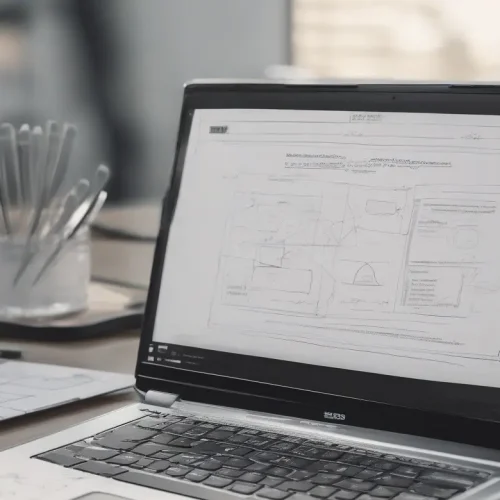Introduction: Why Professional Blog Design is Non-Negotiable
In the digital age, a blog is far more than an online diary; it’s a powerful tool for building brand authority, driving traffic, and generating leads. For a beginner, setting up a blog might seem as simple as installing a pre-made theme. However, to create a platform that truly captivates an audience and achieves business objectives, you must move beyond basic templates and delve into the principles of professional blog design. A well-designed blog isn’t just about looking good—it’s about creating a seamless, intuitive, and memorable user experience that builds trust and encourages visitors to return.
This comprehensive guide will walk you through the essential pillars of designing a professional blog that stands out. We’ll explore everything from foundational strategy and brand identity to user experience (UX), content readability, and technical performance. By understanding these core concepts, you can transform your blog from a simple collection of posts into a strategic asset that works for you.
Chapter 1: The Foundation – Strategy Before Pixels
Before you choose a single color or font, the most critical step in professional blog design is to establish a clear strategy. A visually stunning blog that doesn’t serve a purpose is merely a digital art project. To be effective, your design must be a direct reflection of your goals and your audience’s needs.
Defining Your Blog’s Core Purpose
What is the primary objective of your blog? Your answer will fundamentally shape every design decision. Are you aiming to:
- Generate leads for your business? Your design will need prominent call-to-action (CTA) buttons and lead capture forms.
- Establish thought leadership in your industry? The design should be clean, professional, and prioritize content readability to convey authority.
- Drive affiliate sales? The layout must seamlessly integrate product reviews, comparisons, and clickable links.
- Build a community? Your design should feature an engaging comments section and highlight user-generated content.
Your main goal is the north star of your design process. Every element, from the homepage layout to the navigation menu, should be engineered to guide the user toward this goal.
Understanding Your Target Audience
Who are you trying to reach? A professional blog design for C-suite executives will look and feel vastly different from one targeting teenage hobbyists. Develop detailed user personas to understand your audience’s:
- Demographics: Age, location, and profession.
- Psychographics: Interests, values, and pain points.
- Online Behavior: How they consume content and what devices they use.
This knowledge allows you to tailor your visual language, tone, and user experience to resonate deeply with the right people, making them feel like the blog was created just for them.
Chapter 2: Building a Cohesive Brand Identity
With a clear strategy in place, the next step is to craft a memorable and consistent brand identity. This is the visual language of your blog, and it plays a crucial role in brand recognition and trust-building. Consistency across these elements is key.
Mastering Color Psychology
Color is a powerful communication tool. It evokes emotion and sets the tone before a single word is read. Instead of picking colors at random, build a strategic palette.
- Primary Color: This will be the dominant color associated with your brand. It should align with the emotion you want to convey (e.g., blue for trust, green for growth, yellow for optimism).
- Secondary Color(s): These should complement the primary color and be used for less important elements, creating a balanced and harmonious look. Neutral colors like light gray or off-white are excellent for backgrounds.
- Accent Color: This is a contrasting color used sparingly to draw attention to key elements like CTA buttons, links, or important announcements.
A common design principle is the 60-30-10 rule: 60% of the space should be your primary color (often a neutral), 30% your secondary color, and 10% your accent color. This creates a visually pleasing and professional balance.
The Art of Typography
Typography is the voice of your written content. Limiting your font selection is crucial for a clean, professional appearance. A cluttered look created by too many fonts can appear unprofessional and distract the reader.
- Limit Your Fonts: Stick to a maximum of two or three fonts. A common practice is to use one font for headings (a serif or a distinct sans-serif) and another, highly readable font for the body text (often a simple sans-serif like Open Sans or a serif like Georgia).
- Establish Hierarchy: Use size, weight (bold, regular), and style (italic) to create a clear typographic hierarchy. Your main headings (H2) should be larger and more prominent than subheadings (H3), which should stand out from the paragraph text. This guides the reader’s eye and makes content scannable.
- Prioritize Readability: Ensure your body font is easy to read at various sizes and on different devices. Pay attention to line spacing (leading) and letter spacing (kerning) to avoid cramped, illegible text blocks.
Chapter 3: The Blueprint – Layout and User Experience (UX)
A successful blog is built on a foundation of exceptional user experience. A visitor should be able to navigate your site effortlessly and find what they need without confusion or frustration. This is where a thoughtful layout and intuitive design come into play.
Designing for Intuitive Navigation
Your navigation menu is the primary roadmap for your users. It should be simple, logical, and visible on every page. Organize your content into clear, distinct categories (e.g., “Web Design,” “SEO,” “Marketing”) and use straightforward labels. Include a prominent search bar to help users find specific topics quickly. A cluttered or confusing navigation menu is one of the fastest ways to lose a visitor.
Harnessing the Power of Whitespace
Whitespace (or negative space) is the empty area around design elements. Far from being wasted space, it is a vital component of professional blog design. Proper use of whitespace:
- Improves Readability: It gives content room to breathe, preventing long blocks of text from feeling overwhelming.
- Creates Focus: It helps guide the user’s eye toward important elements, like a CTA or a key image.
- Conveys Professionalism: A clean, uncluttered layout signals elegance and sophistication.
Embracing a Mobile-First, Responsive Design
Today, the majority of web traffic comes from mobile devices. A “mobile-first” approach means you design the blog experience for the smallest screen first and then adapt it for larger screens like tablets and desktops. A responsive design automatically adjusts the layout to fit any screen size, ensuring a seamless experience for every user. This is no longer optional; it is a fundamental requirement for any professional website and a critical factor for SEO.
Chapter 4: Content Presentation – Designing for Readability and Engagement
Even the best content will fail if it’s presented as a monolithic “wall of text.” The design of your individual blog posts is just as important as the overall site layout. The goal is to make your content as easy and enjoyable to consume as possible.
Structuring Content for Skimmers
Most online readers skim before they commit to reading. Structure your content to cater to this behavior.
- Compelling Subheadings (H2, H3): Break up your text into logical sections with descriptive subheadings. This not only improves readability but also helps with SEO.
- Short Paragraphs: Keep paragraphs to 2-4 sentences. This is visually less intimidating and easier to digest, especially on mobile screens.
- Bulleted and Numbered Lists: Use lists to present information concisely and make key points stand out.
- Bold Text: Use strong tags to emphasize key phrases and concepts, drawing the reader’s attention to the most important takeaways.
Integrating High-Quality Visuals
Images, infographics, and videos break up the text and can often explain complex ideas more effectively than words alone. Ensure all visuals are high-resolution, relevant to the content, and consistent with your brand’s aesthetic. Use descriptive alt text for all images to improve accessibility and provide SEO benefits.
Chapter 5: Advanced Considerations for a Polished Design
Once you’ve mastered the fundamentals, a few advanced elements can elevate your blog from good to great, enhancing credibility and user trust.
Designing a Strategic Homepage
Your homepage is your blog’s front door. It should immediately communicate who you are, what you write about, and who you’re for. A professional blog homepage often includes a hero section with a clear value proposition, a selection of featured or recent posts, social proof like testimonials or logos, and a clear call to action, such as a newsletter sign-up form.
Prioritizing Web Accessibility (a11y)
A truly professional blog design is accessible to everyone, including people with disabilities. This is not only ethical but also broadens your potential audience. Key considerations include:
- Color Contrast: Ensure there is sufficient contrast between your text and background colors for readability.
- Keyboard Navigation: All interactive elements should be usable with a keyboard alone.
- Semantic HTML: Use HTML tags correctly (e.g., `
Conclusion: Design as a Strategic Function
In conclusion, professional blog design is a multi-faceted discipline that goes far beyond surface-level aesthetics. It’s a strategic process that involves understanding your purpose, knowing your audience, building a cohesive brand, and prioritizing user experience above all else. By focusing on a clear strategy, a clean layout, excellent readability, and technical performance, you create an environment where your content can truly shine. An investment in thoughtful design is an investment in the credibility, growth, and long-term success of your blog.
Sources:
For further reading on user experience and design principles, consult these authoritative sources:






